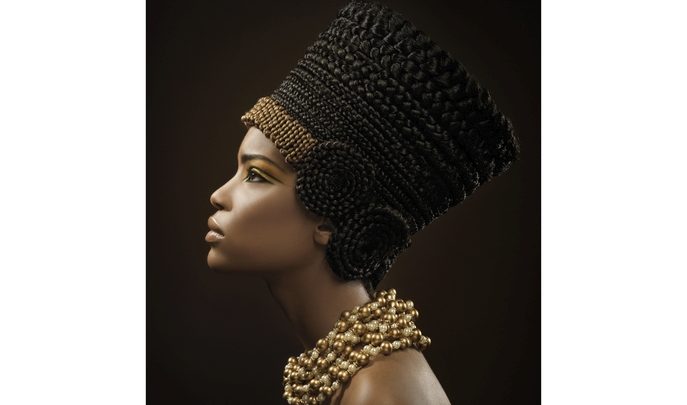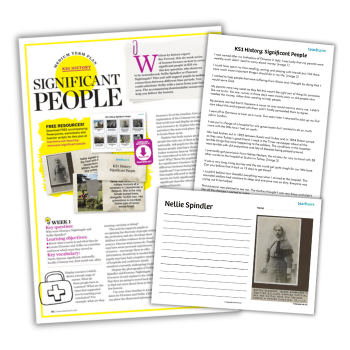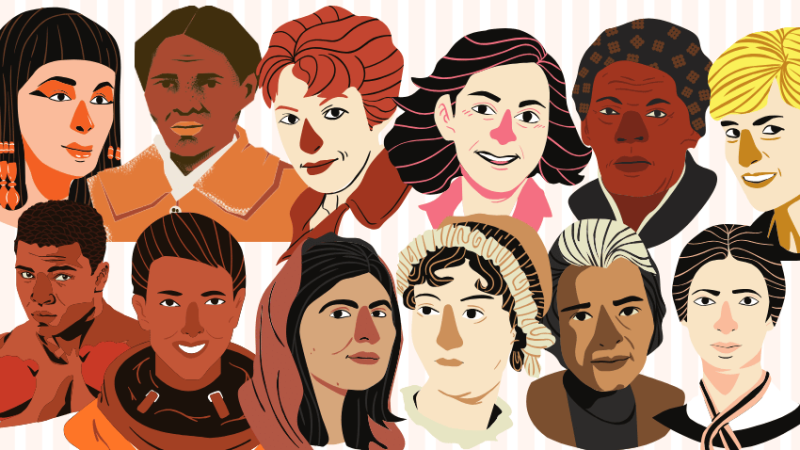History or Her Story? – Women of historical significance for your KS1/KS2 curriculum

From the rich and powerful Zubayda, to the supreme warrior Lady K᾿abel, we must give the women who have helped shaped the world equal billing in our studies of the past, says Alf Wilkson…

- by Alf Wilkinson
- CPD manager for the Historical Association & former head of history

Mao Zedong, the communist leader of China, when trying to change traditional attitudes of Chinese society towards women, once famously said, ‘Women hold up half of the sky,’ – but do women hold up half of your curriculum? How well represented are they in the significant individuals you look at during Key Stage 1 and Key Stage 2?
Of course, some women are very familiar – Florence Nightingale and Mary Secole; Boudicca; perhaps Queen Elizabeth (I and II) and Victoria. But could we do better?
1. Stone Age – The Red Lady of Paviland
Let᾿s start with the Red Lady of Paviland, who, confusingly, turns out not to be a woman at all, but a man wearing a necklace of shells. In 1823, a vicar came across a skeleton whilst on an archaeological dig in the Gower, Wales. He thought the remains were those of a woman, painted in red ochre dating from the Roman period – hence the name.
The truth, discovered more recently by radio-carbon dating, is that the incomplete skeleton is around 33,000 years old and that of a young male. You can find out more about the Red Lady of Paviland in the BBC series for KS2, Ancient Voices.
It is not always easy to identify the sex of an individual from an incomplete skeleton, as this case proves – so you might use the Red Lady of Paviland to discuss the reliability of evidence.
2. Roman Britain – the female gladiator
In 1996, archaeologists in London discovered what they believe to be a unique grave in Roman Europe – that of a female gladiator (though some historians disagree). Women did fight in the amphitheatre, and there is written evidence to support this from Pompeii, but no other known grave.
You might discuss the role of women in Ancient Rome using the female gladiator, or you could ask about the significance of the grave. As already mentioned, it is the only one found (so far) throughout the Roman Empire.
3. Anglo Saxons – Abbess Hilda of Whitby
Abbess Hilda of Whitby founded, and became head of, a large mixed monastery in the seventh century. Her learning was famous throughout Europe and kings and others readily sought her advice. She chaired the Synod (church meeting) at Whitby in 664AD where the divisions in the church were ironed out, and everyone agreed to adhere to the rules of the Pope in Rome. She was made a saint after her death and St Hilda᾿s College, in Oxford, is named after her.
Abbess Hilda provides a great opportunity to discuss the role of the church in Saxon times, the work of monasteries and abbeys, and particularly how difficult it was for a single woman to support herself.
4. Vikings – Emma of Normandy
Emma of Normandy was the wife of Æthelred the Unready. When he died, she became the wife of the Viking King Canute – so at one time she was Queen of England, Denmark and Norway. She played an important part in uniting the country, and when Cnut died, her son, Edward the Confessor, became King. It was her Norman connection that was part of the claim for William the Conqueror in 1066. She was indeed a powerful and influential lady.
Emma᾿s story could be a starting point from which to explore what happened to rich ladies when they became widows – how easy was it for them to make a life for themselves? Why was Canute so keen to marry Emma? Was it because of who she was?
5. Ancient Civilisations – Nefertiti, Hatshepsut, Cleopatra, Fu Hao
In Ancient Civilisations, you might choose Nefertiti or Hatshepsut, or even Cleopatra, who was the last pharaoh of Egypt and provides a link to the Roman Empire and Julius Caesar, all of which might be familiar to you.
If you study the Shang Dynasty, you really ought to focus on Fu Hao, a powerful ruler and army leader from around 1200BC. Much of what we know about the Shang – their crafts, their weapons, their gods, their clothes – comes from the artefacts found in her grave, excavated since 1976. So far, it is the only royal Shang Dynasty tomb found that still contained all its burial goods.
Can the children use the artefacts found in Fu Hao᾿s tomb to build up a picture of life in Shang times? What do the artefacts in her grave tell us about life at the time? What can᾿t they tell us?
6. Non-European Society – Zubayda
The non-European society options provide us with further examples of powerful and influential women. From Baghdad came Zubayda, who died in 831AD and was said to be the richest and most powerful woman in the world at the time. Famous for her wisdom and good works, she was responsible for (and funded) a series of way-stations and wells all the way from Baghdad to Mecca, thus making it easier and safer to make the Haj, or pilgrimage to Mecca, that each Muslim is expected to perform during their lifetime.
What was it like to go on a Haj at the time of Zubayda – and how does this compare with making the pilgrimage today? Children can research the impact her work made at the time, and how it has been viewed since.
7. Maya – Lady K᾿abel
Lady K᾿abel was a Maya queen and military ruler from the Classical period of the Maya in the 7th Century. Her tomb in Guatemala was only discovered in 2012. Her title of ‘supreme warrior᾿ meant she was more important than her husband, the King. Archaeologists are still unsure of the facts, but her tomb, like that of Fu Hao, contained lots of artefacts that help us understand her life and times.
It also shows us how new evidence can change the way we view things, by providing new information or support for one theory as opposed to another – or simply adding to our understanding of life at the time.
We know very few named individuals from Maya times, so it is quite exciting to have a specific individual to story. Again, this is the perfect opportunity to discuss the historical significance of an individual, both then and now.
Browse more Mayans KS2 resources.
8. Ancient Greece – Agnodice of Athens
Finally, don᾿t forget Ancient Greece, where Agnodice of Athens became, in the 4th Century BC, the first female doctor (she dressed as a man in order to train). She was so successful that she was accused of seducing the women of Athens; to prove otherwise, she stripped in front of a jury of men and won her case.
Again, there is some conjecture about the truth of this story – it may or may not be true – but Agnodice did exist and worked successfully as a doctor at a time when it was an all-male profession.
What is the legacy of Greek medicine? This is a good question to explore, alongside understanding why it was so difficult for Agnodice, and all women, to become a doctor at that time. You might contrast her experience with that of Elizabeth Garrett Anderson and her struggles to become a doctor in Victorian England. This rapid survey through most of the history study units cannot, and does not, hope to do justice to the many women who have played a significant part in history. But I hope we have done enough to arouse your interest and encourage you to take another look at your schemes of work, and including some, if not all, of these important figures as a way of reflecting the fact that ‘women hold up half the sky᾿.
Alf Wilkinson taught for many years and is now retired. He is a member of the Historical Association’s Primary Committee, and sits on the editorial board of its journal, Primary History










